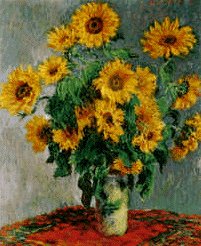

![]()

MONET, Claude (1840-1926). The leader of the 19th-century
impressionist art movement, Claude Monet continued throughout his long career to pursue
its goals. Monet preferred to paint outdoors, directly from nature. Almost all his work
shows his desire to capture on canvas the changing effects of light.
Monet was born in Paris on Nov. 14, 1840, and spent his youth in Le Havre,
where his father worked as a grocer. In 1859 Monet went to Paris to begin the serious
study of art. He spent most of his time, however, in a cafe frequented by artists and
intellectuals. In 1862, after an interval of military service, he returned to Paris and
entered the studio of Charles Gleyre. There he met Pierre Auguste Renoir, Alfred Sisley,
and Jean-Frederic Bazille. Soon, however, the four left Gleyre, and Monet led them on an
expedition to the Fontainebleau Forest, where he introduced them to open-air painting.
After gaining acceptance into the Salons of 1865 and 1866, Monet suffered a
series of reversals. He was deep in debt, and his huge painting 'Women in the Garden' was
rejected at the 1867 Salon. That same year his mistress, Camille Doncieux, gave birth to
their first child, a son, Jean. Without a permanent home or an income, Monet lodged with
friends and borrowed what money he could. At times he was even too poor to buy paint or
canvas. In 1870 Claude and Camille were married. Their financial situation became worse
during the next few years. Camille's health declined following the birth of their second
son, Michel, and in 1879 she died.
![]()